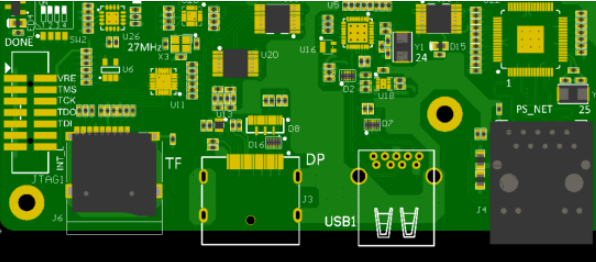pcb digital circuit interference
In the design of electronic systems, in order to avoid detours and save time, the requirements of anti-interference should be fully considered and met, and anti-interference remedial measures should be avoided after the design is completed. There are three basic elements that form interference:
(1) Interference source, which refers to the components, equipment or signals that generate interference.
It is described in mathematical language as follows: du/dt. The place where di/dt is large is the interference source. For example, lightning, relays, thyristors, motors, high-frequency clocks, etc. may all become interference sources.
(2) Propagation path, which refers to the path or medium through which interference
propagates from the interference source to the sensitive device. The typical interference propagation path is conduction through wires and radiation in space.
(3) Sensitive devices, which refer to objects that are easily interfered with.
For example, A/D, D/A converters, single-chip microcomputers, digital ICs, weak signal amplifiers, etc.
The basic principles of anti-interference design are: suppress interference sources, cut off interference propagation paths, and improve the anti-interference performance of sensitive devices. (Similar to the prevention of infectious diseases)
1 Suppressing interference sources
Suppressing interference sources means reducing the du/dt and di/dt of the interference sources as much as possible. This is the most important and most important principle in anti-interference design, and it often achieves twice the result with half the effort. Reducing the du/dt of the interference source is mainly achieved by connecting capacitors in parallel at both ends of the interference source. Reducing the di/dt of the interference source is achieved by connecting an inductor or resistor in series with the interference source loop and adding a freewheeling diode.
Common measures to suppress interference sources are as follows:
(1) Add a freewheeling diode to the relay coil to eliminate the back electromotive force interference generated when the coil is disconnected. Adding only a freewheeling diode will delay the disconnection time of the relay. After adding a voltage regulator diode, the relay can operate more times per unit time.
(2) Connect a spark suppression circuit (usually an RC series circuit, the resistor is generally selected from a few K to tens of K, and the capacitor is selected from 0.01uF) at both ends of the relay contact to reduce the impact of electric sparks.
(3) Add a filter circuit to the motor, and pay attention to the capacitor and inductor leads to be as short as possible.
(4) Each IC on the circuit board should be connected in parallel with a 0.01μF~0.1μF high-frequency capacitor to reduce the impact of the IC on the power supply. Pay attention to the wiring of the high-frequency capacitor. The connection line should be close to the power supply end and as thick and short as possible. Otherwise, it is equivalent to increasing the equivalent series resistance of the capacitor, which will affect the filtering effect.
(5) Avoid 90-degree folds when wiring to reduce high-frequency noise emission.
(6) Connect an RC suppression circuit at both ends of the thyristor to reduce the noise generated by the thyristor (this noise may break down the thyristor when it is serious).

2 According to the propagation path of interference, it can be divided into two categories:
conducted interference and radiated interference.
The so-called conducted interference refers to the interference transmitted to the sensitive device through the wire. The frequency band of high-frequency interference noise is different from that of the useful signal. The propagation of high-frequency interference noise can be cut off by adding a filter on the wire, and sometimes it can be solved by adding an isolation optocoupler.
Power supply noise is the most harmful and should be handled with special attention. The so-called radiated interference refers to the interference transmitted to the sensitive device through space radiation. The general solution is to increase the distance between the interference source and the sensitive device, isolate them with a ground wire and add a shielding cover on the sensitive device.






